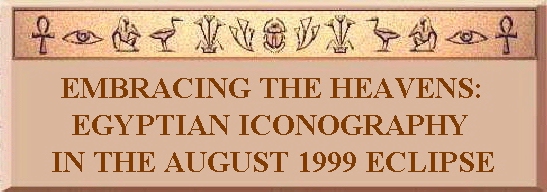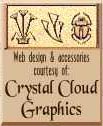
by Nebt Khut Mau1
Jane Sellers in her book, The Death of Gods in Egypt, quotes the above coffin texts as illustrative of a phenomenon known as the diamond ring effect which occurs just before totality during a total eclipse of the Sun. Because the Moon has mountains, parts of the Sun shine through, giving the effect of a brilliant flash of light like a diamond solitare with the corona forming the outline of a ring. Her clearly presented theory makes a good case for the astronomical basis of certain Egyptian god forms.'I am the fiery Eye of Horus, which went forth terrible, Lady of Slaughter, greatly awesome who came into being in the flame of the sunshine, to whom Re2 granted appearings in glory... Mighty is the fear of you, great is the awe of you, mighty is your striking-power, great is your magic in the body of your foes... I have become the Eye of Horus! Behold me, men and gods! Set the fear of me and create awe of me on that plateau of the Stone of Brightness. I have come into being as the Lady of Glorious Appearings, I have reappeared in glory, I have made my being enduring, my flame is behind me, the awe of me is before me... Look with your eyes, you elder gods who aforetime came into existence with the ancestors, on this spirit who has come today! Is the Sole Eye stronger than the gods? So say I to my father Atum. Strength has gone forth to me from your mouth, and it means that I have become Her who is strongest among the gods, and Seth has fallen because of me...Behold me, men and gods! I have become the fiery Eye of Horus.'(Coffin Texts IV)3
Bauval and Handcock in their book, Message of the Sphinx, further investigate astrological correlations between the heavens and the Leonine Sphinx, identifying the Sphinx with the constellation Leo and the very ancient god of Egypt, Heru-Khuti, or Horus of the Two Horizons.4 According to E.A. Wallis Budge, who with Selim Hassan agrees that the Sphinx is older than the pyramids and also connects it to Horus of the Two Horizons, Heru-Khuti represented the path of the Sun from the Mount of Sunrise to the Mount of Sunset.5
Bauval and Handcock further identify Heru-Khuti as Nefer Tum, a composite god who incorporates Ra with Atum, the original creator god. They date this god form to the pyramid age. As Nefer-Tum, he is also the third member of the Memphis triad of Sekhmet and Ptah, the Gods of the earliest capitol. Sekhmet is mentioned in the Pyramid texts of Unas which predate the coffin texts.
Budge, in his book, Egyptian Gods Vol. II, also identifies Hor-Khuti with Horus Behutet or Horus of Edfu, the victorious winged Disk who triumphs over evil. The representations of Horus in this legend confirm the Leonine connection and have much stellar significance. In one depiction, Horus Buhetet has the head of a hawk with a lion-headed penis as god of Generation. In another, his left hand holds a scorpion. He represents the Sun in the southern heavens at midday. This correlates very closely to the eclipse sky in Cornwall, England, on August 11, 1999.
The August 1999 eclipse will take place in the asterism of the Lion, close to the fixed star Ras Elased Australis, the Southern Star in the Lion's Head. The constellation of the Scorpion will be in the second and third houses, with Mars in close conjunction to Northern Scale Al Zuben al Shamaliyyah, a star of the constellation Scales but often known as the Claws of the Scorpion. It is significant in this context that Horus Behutet holds a scorpion in his left hand, where, if one stands facing South, the stars of the Claws of the Scorpion will rise in the east, or to the left, at the time of the eclipse. It is also interesting that the phenomenon which begins totality is addressed in feminine terms (again noted in the text of the observant Ms. Sellers) with titles often attributed to Sekhmet, member of Nefer Tum's triad.
In An Egyptian Hieroglyphic Dictionary Vol I,6 the word utchati refers to the Eyes of Horus. The glyph of the Eye itself is written both ways, symbolizing either the right or left eye; the right eye denoting the Sun, the left eye denoting the Moon. In observed astronomy the motion of the Sun is east to west, or right-handed, while that of the Moon is west to east, or left-handed. There is a glyph written for the left eye, Utchat-Sekmet, attributed to the hieroglyphic text of the Theben Recension of the Book if the Dead. This is suggestive of the disk of the Moon moving leftward to obscure the Sun, resulting in the Diamond ring effect.
Note some of the titles of Sekhmet: "Mighty Lady, Lady of Flame, Great Serpent on the Head of Her Father".7 Sekhmet is always portrayed with the Disk of the Sun on her head, encircled by the uraeus snake. Both the Sekhmet legend and the legend of Horus as the winged Disk relate the defeat of evil and restoration of peace. One is struck by the sentence, "I have reappeared in glory, I have made my being enduring." The Egyptians were aware of cycles, and this eclipse of the first Saros series particularly seems reserved for powerful images especially as it takes place at Mid-Heaven, where Horus looks upon both horizons simultaneously. Could it be that this eclipse will be a time to change the valances of good and evil in the world? Certainly the images written in the stars would agree.
(The author is a professional astrologer residing in New Mexico, U.S.A. She has studied astrology since 1969 and has completed Levels I through III of the National Council for Geocosmic Research (NCGR) certification program. Having also studied archaeology at the University of New Mexico, she has formed an NCGR Special Interest Group (SIG) on Fixed Stars. This group discusses and disseminates astrological and astronomical information on the fixed stars relating to archaeology. If you are a member of the NCGR and would like to participate in this group, please contact her by email at [email protected].)
1Entire article copyright 1999 by Thea Girard Marshall
2Re is synonymous with the Egyptian Sun god, Ra.
3Jane B. Sellers, The Death of Gods in Ancient Egypt (London, England: Penguin Books, 1992) 56.
4Graham Hancock, Robert Bauval, The Message of the Sphinx (New York: Three Rivers Press, 1996) 152-166.
5E.A. Wallis Budge, The Gods of the Egyptians (New York: Dover Publications, Inc. 1964) 470-483.
6E.A. Budge, An Egyptian Hieroglyphic Dictionary (Toronto, Ontario: General Publishing Co,1978) 194.
7Robert Masters, The Goddess Sekhmet (St. Paul, Minnesota:
Llewellyn Publications, 1991) 58-67.
![]()
BACK
TO ASTROLOGY HARVEST ARTICLE LIST
BACK TO ASTROLOGY HARVEST HOME PAGE


